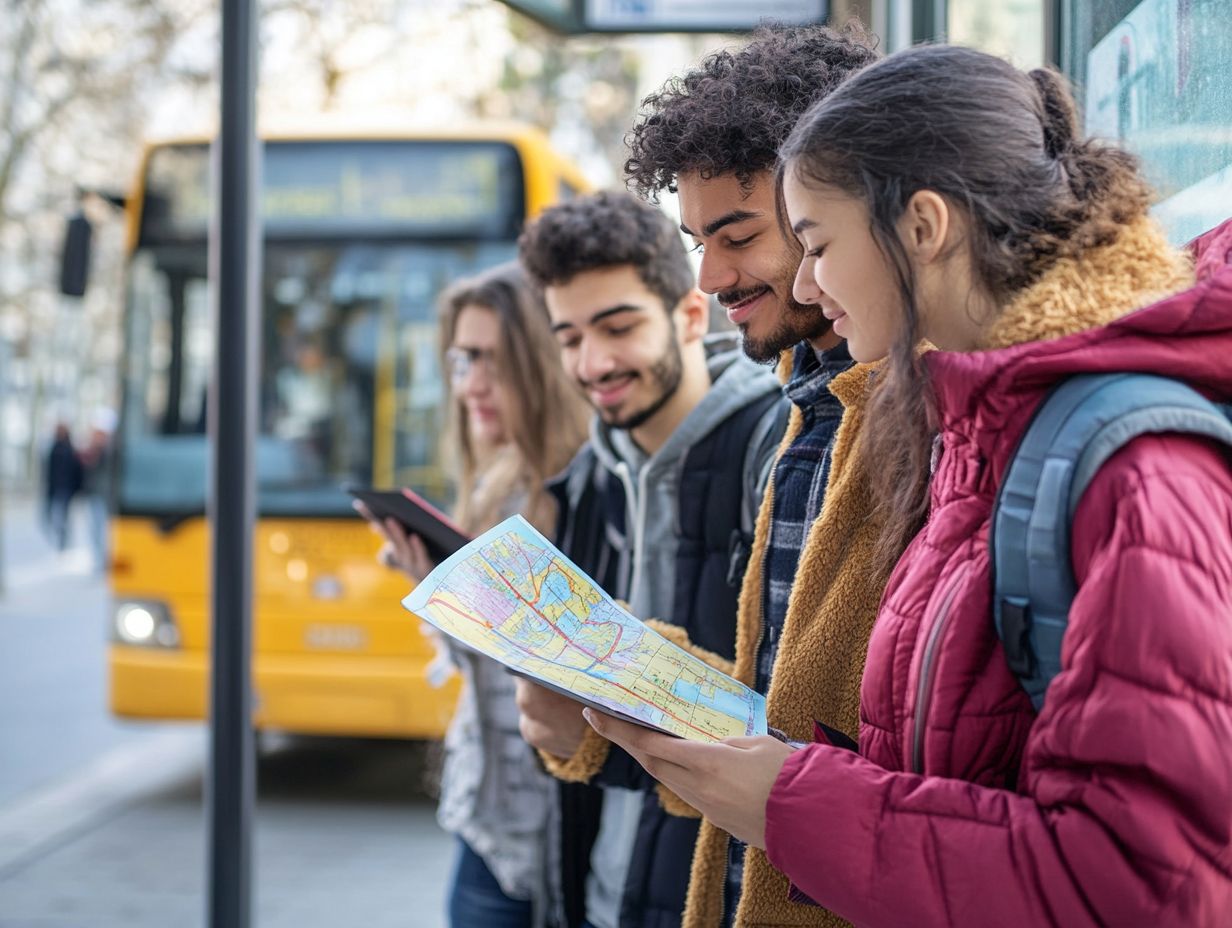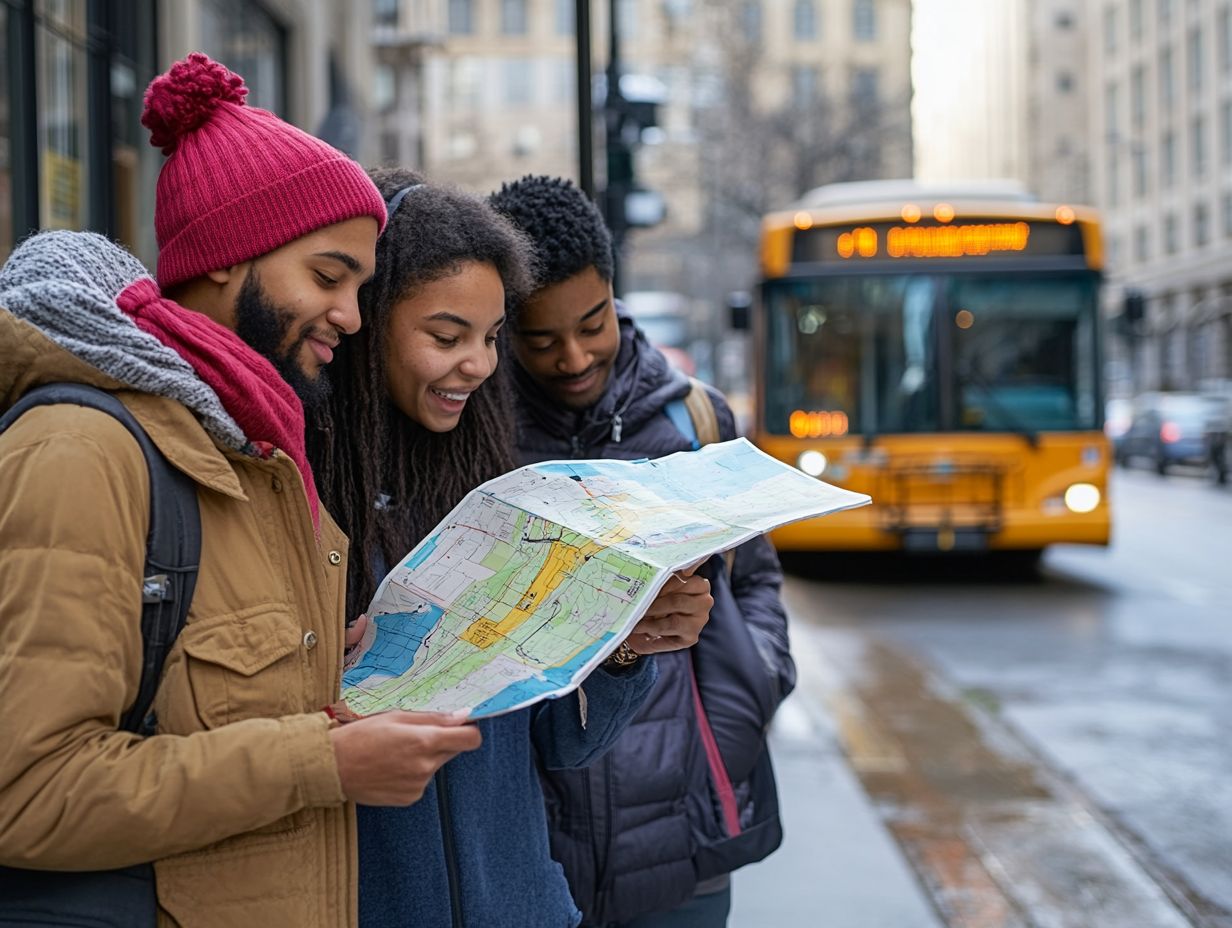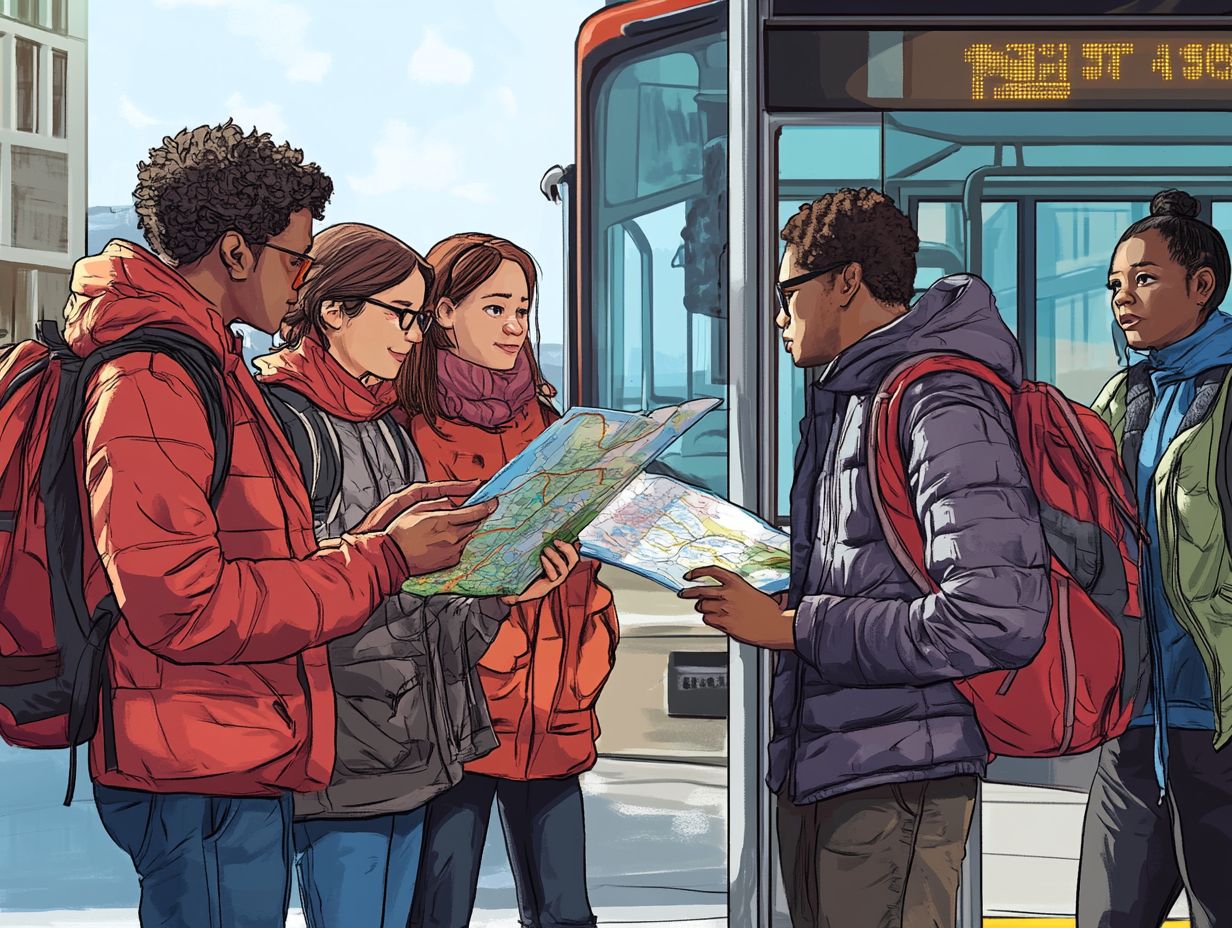Understanding Local Transportation as a Student
Navigating local transportation can truly transform your experience as a student, providing you with both independence and convenience.
Whether you re relying on public transit, exploring alternative options like biking or ridesharing, or searching for the most economical routes, understanding your choices is essential.
This guide will break down various transportation types, share vital navigation tips, discuss budgeting strategies, and highlight safety considerations to ensure your commuting experience is both smooth and secure.
Dive in! Become a savvy traveler in your local area!
Contents
- Key Takeaways:
- Types of Local Transportation
- How to Navigate Local Transportation
- Costs and Budgeting for Local Transportation
- Safety Considerations for Using Local Transportation
- Frequently Asked Questions
- What is local transportation and why is it important for students?
- What types of local transportation are typically available for students?
- How can I save money on local transportation as a student?
- What should I keep in mind when using local transportation as a student?
- Are there any alternatives to using local transportation as a student?
- What resources are available to help students understand local transportation?
Key Takeaways:

- Navigating local transportation as a student can save time and money.
- Understanding schedules and routes is key to using public transportation efficiently.
- Safety should always be a top priority when using local transportation.
Why Understanding Local Transportation is Important for Students
Understanding local transportation is crucial for you as a student. For more insights, check out what you should know about local transportation, as it directly influences your access to quality education, impacting educational outcomes, absenteeism rates, and overall engagement in school.
Having reliable transportation options means you can arrive at school on time and participate in extracurricular activities. It also allows you to reach essential resources like libraries and tutoring programs.
For many, public transit systems act as a vital lifeline, especially in urban areas where owning a private vehicle might not be feasible due to economic constraints.
However, disparities in transit accessibility often stem from economic differences, leaving some families stranded and hindering their children s ability to attend school regularly. By improving transportation infrastructure and implementing targeted policies, these gaps can be bridged. This approach fosters fair access to education, reducing absenteeism and ensuring that you, regardless of your background, have an equal opportunity to thrive both academically and socially within your community.
Types of Local Transportation
The types of local transportation available to you as a student can vary widely depending on your neighborhood and urban setting. You have options like public transit, private vehicles, school buses, and even charter school transportation services.
Each mode comes with its own set of advantages and challenges, influencing your commuting patterns and educational access based on your unique circumstances.
Public Transportation Options
Public transportation options, including buses and subways, are vital for commuter students in urban areas. They offer a reliable way to travel to school while ensuring safety throughout their journeys.
By familiarizing yourself with the available routes and schedules, you can empower your family to make informed choices about your children s daily commutes.
Buses and subways offer many cities, while many also provide trams and light rail services that expand the reach of public transit, making it easier for students to access a variety of educational institutions.
While these modes of transportation are often affordable and extensive, they can also present challenges, such as overcrowding and delays during peak hours.
For families, understanding the safety measures in place like surveillance and well-lit stations is crucial when considering the well-being of your children. Accessibility remains a significant concern as transit systems must cater to families with mobility challenges, ensuring equal opportunities for education and social engagement.
Ultimately, when you compare these options to personal vehicles, the advantages of convenience and environmental sustainability become clear, as public transport increasingly prioritizes these essential factors.
Alternative Modes of Transportation
Alternative modes of transportation, like private vehicles and school buses, are essential for student travel. They are especially important for those attending charter schools or participating in extracurricular activities.
Private vehicles provide your family with flexibility and convenience, allowing you to decide when and how your children travel. This is particularly advantageous for participating in after-school programs or sports. Conversely, school buses offer a reliable and cost-effective transportation solution for students from various backgrounds, helping to create a more equitable educational landscape.
Both methods of transport play a significant role in influencing school choice, as families weigh factors like distance, safety, and accessibility when selecting an educational institution. By addressing the unique transportation needs of different demographic groups, you can ensure that all students have equitable access to quality education and enriching extracurricular activities.

Navigating local transportation effectively is essential for students and families. It requires a keen understanding of the available public transit systems, schedules, and routes to ensure timely commutes to school.
By embracing practical tips and utilizing available resources, you can significantly enhance your commuting experience and minimize travel times.
Tips and Tricks for Using Public Transportation
Using public transportation can become a smooth and safe experience for you as a student with the right tips and tricks. You can take charge of your travel by following essential safety practices and mastering time management techniques to navigate public transit like a pro.
- Familiarize yourself with the routes and schedules. This knowledge can lessen the stress of traversing unfamiliar areas.
- Your parents can help you craft a reliable travel plan and encourage you to leave early to account for any unexpected delays.
- Stay aware of your surroundings while traveling for your personal safety.
- Avoid empty subway cars and choose to sit near the operator for added security.
- Communicate with your family regularly about your experiences and concerns to foster a supportive environment.
Understanding Schedules and Routes
Understanding the schedules and routes of public transportation is essential for you as a commuter student, as it directly impacts your attendance and ability to arrive at school on time. By learning how to navigate transit schedules, you can ensure that you have a reliable means of getting to school.
Being able to read and interpret public transit schedules accurately allows you to plan your daily routines effectively. Staying informed about any route changes or delays is crucial, as these factors can significantly affect your travel times.
This awareness enhances your commuting efficiency and helps you maintain consistent attendance. By utilizing tools like mobile apps and website resources, you can receive real-time updates and alerts, minimizing stress during those hectic morning hours.
Grasping these nuances can truly transform your daily journey into a smoother experience for everyone involved.
Costs and Budgeting for Local Transportation
Costs linked to local transportation can substantially affect your family’s budget, especially if you’re navigating the challenges of a low-income household. It becomes crucial to explore a variety of options to manage these expenses effectively.
By utilizing public transportation or seeking scholarships, you can discover ways to ease financial pressures while ensuring that your children have access to quality education.
Start planning your travel today! Explore local transport options and enjoy a smoother commute!
How to Save Money on Transportation Expenses
Saving money on transportation expenses is a critical concern for families, especially when budgets are tight. There are several effective strategies to make your commuting more affordable.
You can use public transportation options, plan your travel routes in advance, and take advantage of discounts to significantly cut costs.
Having a thorough understanding of local transit schedules and routes can lead to more efficient journeys. You might also consider exploring carpooling arrangements to share rides and expenses with neighbors or friends.
Check if your community offers financial assistance or discounted fares for low-income families. It’s wise to investigate these resources.
Organizing a monthly transportation budget that accounts for necessary travel will help you prioritize spending and identify potential savings. Visit local community centers to find valuable information on these opportunities, allowing you to navigate your transportation needs more economically.
Safety Considerations for Using Local Transportation

Safety is essential for students utilizing local transportation, particularly when depending on public transit systems for their daily commutes.
Families should prioritize a thorough understanding of safety protocols, ensuring that students are well-prepared to navigate various situations during their journeys to and from school.
Staying Safe While Using Public Transportation
Staying safe while using public transportation is vital for you as a student, especially considering the various challenges you may encounter during your daily commutes. Your family can play a pivotal role in teaching you effective safety practices, ensuring your well-being and confidence.
By creating an open environment where you feel comfortable discussing your experiences, your family can help improve your situational awareness, or being aware of your surroundings. Always remember to stay alert; avoid distractions like headphones or mobile devices when waiting for transport.
Practicing safe waiting habits like standing in well-lit areas and being vigilant about your surroundings can significantly enhance your safety. Your family should also guide you on how to identify trustworthy sources, such as uniformed personnel or nearby adults, in case any unsettling situations arise.
By instilling these proactive measures, you ll be empowered to make informed decisions while using public transportation, ultimately leading to a safer commuting experience!
What to Do in Case of Emergency
In the unfortunate event of an emergency while using public transportation, knowing the right steps to take can make all the difference in ensuring safety for students and families. Quick action saves lives!
Being prepared with clear procedures and effective communication strategies will help mitigate risks and facilitate a swift response to any dangerous situation.
To enhance safety, it’s essential for students to get to know emergency exits and protocols specific to the transportation they are using, whether it be buses or subways. Families play a pivotal role in this preparation by discussing various scenarios be it a medical emergency or an evacuation so that children understand how to respond calmly and effectively.
Equipping children with vital items like emergency contact information and a small first aid kit empowers them to navigate unexpected events with confidence. Regular discussions about how to handle different emergencies can bolster awareness and foster a collective mindset focused on safety.
Frequently Asked Questions
What is local transportation and why is it important for students?
Local transportation refers to the various modes of transportation available within a certain area, such as buses, trains, and subways. It is important for students because it provides a convenient and cost-effective way to travel to and from school, as well as other locations in the community.
What types of local transportation are typically available for students?

Transportation options for students vary by location. Common choices include public buses, subways, school buses, and university shuttles.
How can I save money on local transportation as a student?
You can save money on local transportation by using student discounts or passes. Carpooling with classmates and utilizing free shuttle services from your school are also great options.
What should I keep in mind when using local transportation as a student?
Planning your route and schedule in advance is crucial. Always keep your student ID handy and be aware of safety precautions when using public transport.
Are there any alternatives to using local transportation as a student?
You can bike or walk to school, or use ride-sharing services. However, these options may not work for everyone based on their circumstances.
What resources are available to help students understand local transportation?
Many resources help students navigate local transportation. Online maps, school transportation offices, and local transit authority websites are useful tools.






